This is not about children's clothing. This is about dreams.

Right, it is because I'm reminded that for everything that is unnerving and wrong in the world, for all that things seem to degenerate into apathy or blunt self-service, dreams are still alive. Not a lot of them, and not a lot that succeed, but there are still a few out there.
So every year, a half million or so people who still have the dream (or one of them) turn out to an airport in Wisconsin to celebrate aviation, dreams, and community. They arrive by air, most of them, flying in aboard everything from restored Piper Cubs that followed freeways using road maps (I had a friend in college who did this with his dad -- a senior United Airlines captain -- for several years) to state of the art Gulfstreams. They camp out in the fields, in tents pitched underneath wings or fusualages (though probably that's more likely for the guys who flew in the Piper Cubs than the Gulfstreams).
 They come to shop -- all the big players will be there with hardware both new and established right alongside the dreamers who think they have a better (or just different) way of doing things. They come to look -- at P-51's with aluminum skin shining and gleaming in the sun, at F-22's cordoned off behind ropes, at Citation Mustangs that probably represent the mean upper bound of "I could do that" for most general aviation pilots, at thoroughbread Moonys and workman Cessnas and svelte Cirrusses. They come to mourne, with Steve Fosset and Lancair the most strongly missed this year, though the one will live on in timeless accomplishments and the other as an upmarket division of Cessna. They come to learn, some at seminars organized by volunteers and vendors where PowerPoint decks and simulations walk through the basics of operating that new Garmin (amazing how this startup is now nearly synonymous with aircraft navigation -- I guess some of the dreamers do make it) or advanced airmanship and recovery from unusual attitudes but most from the countless handwaving demonstrations going on around the flightline:
They come to shop -- all the big players will be there with hardware both new and established right alongside the dreamers who think they have a better (or just different) way of doing things. They come to look -- at P-51's with aluminum skin shining and gleaming in the sun, at F-22's cordoned off behind ropes, at Citation Mustangs that probably represent the mean upper bound of "I could do that" for most general aviation pilots, at thoroughbread Moonys and workman Cessnas and svelte Cirrusses. They come to mourne, with Steve Fosset and Lancair the most strongly missed this year, though the one will live on in timeless accomplishments and the other as an upmarket division of Cessna. They come to learn, some at seminars organized by volunteers and vendors where PowerPoint decks and simulations walk through the basics of operating that new Garmin (amazing how this startup is now nearly synonymous with aircraft navigation -- I guess some of the dreamers do make it) or advanced airmanship and recovery from unusual attitudes but most from the countless handwaving demonstrations going on around the flightline:"So I'd gotten her slowed way too far down (as you can see from my hand being held figertips-high) and then she started to wallow (as you can see by my hand slaloming back and forth) and I still had to make the turn to final (as I now move my whole body to re-orient the demonstration)..."
But above all they come to dream and to live the dream. To, for just a week, stand in the company of those who love what they love, to envision and argue for a world that accepts aviation in a way it never again will, to shake hands with their heroes, to ogle their next dream jet, plan their next fly-in, to dine on brats and soothe sunburns.
And some of these dreamers take their visions and stake everything on the fulfillment of that dream. They found companies, launch crusades, and plan whole new eras of aviation and heroism. I sit here, in my office, a cynical product of The Large Corporation and, even more so, of the hard lessons of 2000 when many an ill conceived dream or scheme came to naught but some bad debt, and I wonder why they still do it. Perhaps one in ten of the brilliat ideas launched or announced at this year's Oshkosh will survive to the next great fly-in. Perhaps one in ten of those will successfully reach even the barest scratching definition of success. And perhaps one in ten of those will truly thrive and change the world -- and even then will they do it in the way forseen?
The folks at Garmin, a success story four paragraphs ago, admit that their consumer products do much to subsidize the aviation side of the house. The money, even for the manufacturer of the mighty G1000, is in putting your technology into Chevrolets and Nokias. Half a decade ago, Eclipse was going to change the universe. Today, their CEO is ousted and their customers sweating. Moony has declared bankruptcy more times than Liz Taylor has been married and is cutting back at the turndown point of another of the latest of their boom-bust cycles. Hard working dreamers founded the Rocket Racing League -- great idea, Long-EZ look-alikes soaring through the air blending NASCAR guts with the dream of some pulp science fiction writer's future. Elon Munsk builds rockets (OK, I'm deviating from Oshkosh here, but bear with me, I'm being emotional and I promise I'll get it back home eventually) hoping to simultaneouse revolutionize and undermine the established way of doing the space business. Just as did Kistler (in litigation), Roton (in litigation), and Orbital Sciences (successful but not revolutionary).
The linking idea is that all of these people share a dream -- and I am shocked to see how many continue to stake what they have on a dream. I fear the day that they trade in the dewar of liquid oxygen for the bottle of gin that seems, to me to, lie almost inevitably at the end of such a road. But they still do it. They attract investors and they find customers and some of them do make it. And every one of those rare successes brings more who are willing to take the risk. And for all my weepy impending-tragedy emotion, thak God that they keep coming.
Because they remind me why I keep a poster of a Citation Mustang (for I know my "I could do that" limits) next to my monitor and laptop at work and a shot of the 3rd green at Pacific Dunes as my desktop background. It reminds me of why I put this blog out into the ether hoping that someone reads it and learns or grows or enjoys. It reminds me of why I plan the second novel I will write (for this is a dream with a chance of fulfilment even lower that of success in the aerospace marketplace during a time of economic uncertainty!).
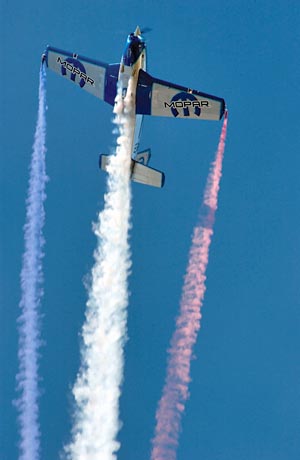 The dream is alive. All of the dreams are alive -- the fliers, the writers, the athletes, the musicians, everyone who casts aside the irritating and mundane bounds of conventionality and expectation and takes the chance. Wheter you pin everything you have or nothing more than than your own emotions on it, if you chase that dream then you are keeping the spirit alive.
The dream is alive. All of the dreams are alive -- the fliers, the writers, the athletes, the musicians, everyone who casts aside the irritating and mundane bounds of conventionality and expectation and takes the chance. Wheter you pin everything you have or nothing more than than your own emotions on it, if you chase that dream then you are keeping the spirit alive.At last, the lader, which had been built slowly, slowly, one hope at a time, reached up to the clouds. And the dreamer began to climb.
So to all of you at Oshkosh, those of you flying in in a restored T-34, those of you who putting down your deposit for a Cirrus Vision, those of you hawking a rain-repellant coating, those of you just there to see and touch and smell, thank you.

 But just a few parting thoughts:
But just a few parting thoughts: Take a collection of these parts and you can sort of figure out what they do together. This part wiggles back and forth, it turns this cam, which actuates this other switch whenever it reaches above a certain point and that connects to these magnets...
Take a collection of these parts and you can sort of figure out what they do together. This part wiggles back and forth, it turns this cam, which actuates this other switch whenever it reaches above a certain point and that connects to these magnets... But when faced with the obscure opacity of a CPU, what can we do? The algorithms inside are so mutable and changeable, so obtuse to so many people and so possessed of a trapdoor obfuscation that even the most talented struggle to pick them apart. The circuit diagrams reveal nothing but an artistic beauty -- a city from 20,000 feet. Detailed descriptions of functioning and register layout from
But when faced with the obscure opacity of a CPU, what can we do? The algorithms inside are so mutable and changeable, so obtuse to so many people and so possessed of a trapdoor obfuscation that even the most talented struggle to pick them apart. The circuit diagrams reveal nothing but an artistic beauty -- a city from 20,000 feet. Detailed descriptions of functioning and register layout from 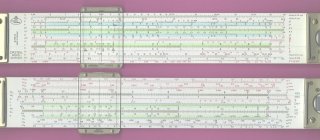 And so that is why I find myself amassing things like slide rules and vintage aircraft manuals. For all the mystery of the log-log slide rule, the functioning is out there in the open, tactile and accessible and made of slightly yellowed phenolic. It is also why I desperately like the idea of collecting old boatanchor radios and filling my office with the warm sweet glow of vacuum tubes and the swirling tones of single sideband. I know that I will never do this, but I like the idea. I once spent well over $3,500 on an
And so that is why I find myself amassing things like slide rules and vintage aircraft manuals. For all the mystery of the log-log slide rule, the functioning is out there in the open, tactile and accessible and made of slightly yellowed phenolic. It is also why I desperately like the idea of collecting old boatanchor radios and filling my office with the warm sweet glow of vacuum tubes and the swirling tones of single sideband. I know that I will never do this, but I like the idea. I once spent well over $3,500 on an  I'd been using their free trial since I created The Noodle Book and, last weekend, it expired. I was fine with that -- I love the free trial culture that is endemic among Mac developers. There is no way I can really get the feel of software without using it, and I've definitely bought programs because I could try them when, without a demo, I'd have done nothing and soldiered on with what I had.
I'd been using their free trial since I created The Noodle Book and, last weekend, it expired. I was fine with that -- I love the free trial culture that is endemic among Mac developers. There is no way I can really get the feel of software without using it, and I've definitely bought programs because I could try them when, without a demo, I'd have done nothing and soldiered on with what I had.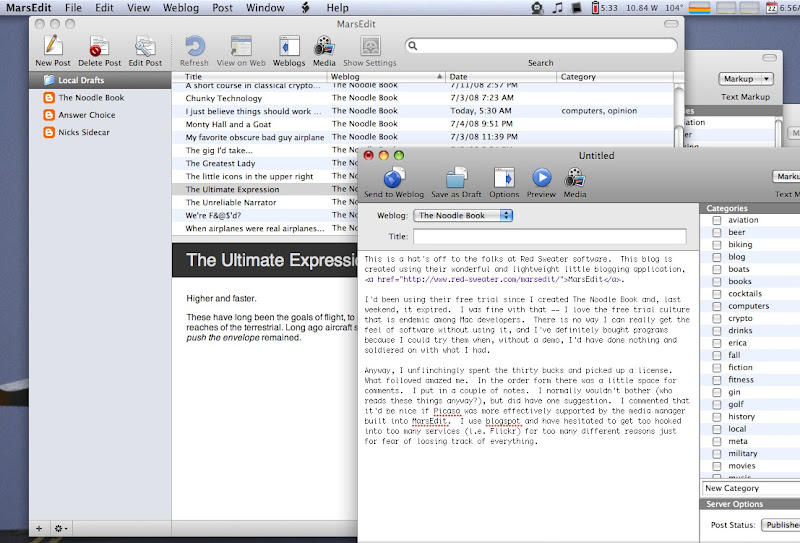
 2008's been a bad year for the Air Force. We lost a B-52 and her crew today -- an airplane that was flying for probably 45 years, flew during (though not necessarily in) five or so wars, and had probably outlasted the first men to sit in her cockpit. Now granted, military flying is always dangerous and 45 year old airplanes carry their own dangers. But we are talking about a type with one of the best records in the Air Force -- probably not least because all the bugs had been worked out by now!
2008's been a bad year for the Air Force. We lost a B-52 and her crew today -- an airplane that was flying for probably 45 years, flew during (though not necessarily in) five or so wars, and had probably outlasted the first men to sit in her cockpit. Now granted, military flying is always dangerous and 45 year old airplanes carry their own dangers. But we are talking about a type with one of the best records in the Air Force -- probably not least because all the bugs had been worked out by now! So that's my question -- who is minding the store over there? Whoever you are, let me tell you that General Le May wouldn NOT be proud. You'd all have found yourself off flight duty and given a dressing down that even Admiral Rickover would have admired. I know I'm jumping to conclusions, but this isn't about a single crash -- its about something that seems too significantly clustered to be mere coincidence. And non-coincidences demand a search for universal causes.
So that's my question -- who is minding the store over there? Whoever you are, let me tell you that General Le May wouldn NOT be proud. You'd all have found yourself off flight duty and given a dressing down that even Admiral Rickover would have admired. I know I'm jumping to conclusions, but this isn't about a single crash -- its about something that seems too significantly clustered to be mere coincidence. And non-coincidences demand a search for universal causes.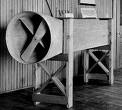 Congratulations, you are now at the Orville and Wilbur Wright level of wind tunnel sophistication.
Congratulations, you are now at the Orville and Wilbur Wright level of wind tunnel sophistication. And since we now have a closed system, we can feel free to chill or pressurize the test section to our heart's content. Pressurize? Wouldn't you want to do the opposite, to test an airplane that is flying at the thin air of high altitude? Yeah, you would, if it wasn't for the irritating fact of the Reynold's number that always intrudes right about now. The Rn is about the most confusing concept in aeronautics, so I'm going to try to keep it simple. Have you ever heard the story about how someone (usually NASA or the Air Force or some other Big Agency that is fun to embarrass) tried to test a fruit fly (or honey bee, or dragon fly, or some other small insect) in a wind tunnel and proved beyond a doubt that it couldn't fly? Its total B.S. If you stick a scaled up model of a honey bee in a wind tunnel and try to simulate it flying it will, in fact, totally fail to fly. But the reason for this is well understood. It is the Reynolds number. And for the same reason, if you put a scaled up model of a 787 in a plain-Jane wind tunnel you'll get aero data back that is only a teensy weensy bit more accurate than you did for the unflyable bumble bee.
And since we now have a closed system, we can feel free to chill or pressurize the test section to our heart's content. Pressurize? Wouldn't you want to do the opposite, to test an airplane that is flying at the thin air of high altitude? Yeah, you would, if it wasn't for the irritating fact of the Reynold's number that always intrudes right about now. The Rn is about the most confusing concept in aeronautics, so I'm going to try to keep it simple. Have you ever heard the story about how someone (usually NASA or the Air Force or some other Big Agency that is fun to embarrass) tried to test a fruit fly (or honey bee, or dragon fly, or some other small insect) in a wind tunnel and proved beyond a doubt that it couldn't fly? Its total B.S. If you stick a scaled up model of a honey bee in a wind tunnel and try to simulate it flying it will, in fact, totally fail to fly. But the reason for this is well understood. It is the Reynolds number. And for the same reason, if you put a scaled up model of a 787 in a plain-Jane wind tunnel you'll get aero data back that is only a teensy weensy bit more accurate than you did for the unflyable bumble bee.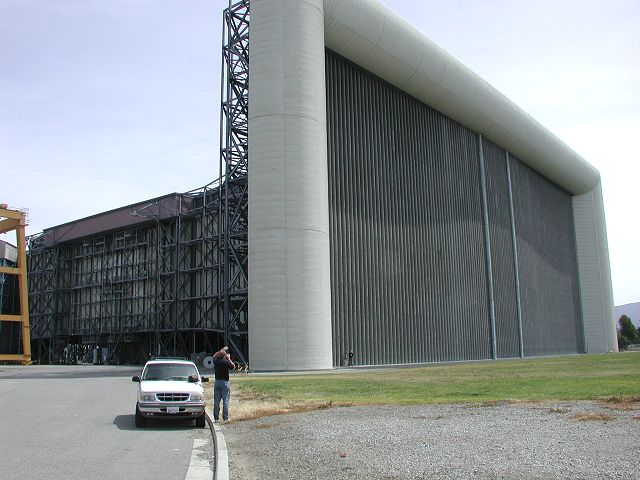 I take that back. We can imagine. Air, at a bumble bee's scale, is much closer to water than we might think. So all kinds of crazy viscous effects take place. But what does this mean for our wind tunnel? Even assuming we don't want to test bumble bees, it has grave consequences. It is unrealistic to test full size airplanes at anything close to flight speed. The largest wind tunnel in the world was located at NASA's Ames Research Center. It was a landmark. We used to say things like "two exits past the wind tunnel." It had a test section that was 80 feet high and 120 feet wide, and so could test small airplanes in full size or larger airplanes at a reasonable scale. But it was only good for a hundred miles an hour or so.
I take that back. We can imagine. Air, at a bumble bee's scale, is much closer to water than we might think. So all kinds of crazy viscous effects take place. But what does this mean for our wind tunnel? Even assuming we don't want to test bumble bees, it has grave consequences. It is unrealistic to test full size airplanes at anything close to flight speed. The largest wind tunnel in the world was located at NASA's Ames Research Center. It was a landmark. We used to say things like "two exits past the wind tunnel." It had a test section that was 80 feet high and 120 feet wide, and so could test small airplanes in full size or larger airplanes at a reasonable scale. But it was only good for a hundred miles an hour or so. All kinds of other crazy things get involved. Test sections with slotted or perforated walls backed by giant suction pumps to clear away turbulent flow or dissipate shockwaves streaming off the model. Flexible tunnel sections (supported by immense hydraulic jacks) that change shape to optimize test conditions for different speeds and conditions. Pure nitrogen test atmospheres for greater predictability and easier cooling (just spray liquid nitrogen into the tunnel and bleed off the excess pressure).
All kinds of other crazy things get involved. Test sections with slotted or perforated walls backed by giant suction pumps to clear away turbulent flow or dissipate shockwaves streaming off the model. Flexible tunnel sections (supported by immense hydraulic jacks) that change shape to optimize test conditions for different speeds and conditions. Pure nitrogen test atmospheres for greater predictability and easier cooling (just spray liquid nitrogen into the tunnel and bleed off the excess pressure).![B4BF1790[2].jpg](http://lh4.ggpht.com/strauss.nick/SH6qmB1BajI/AAAAAAAAAIg/rUT0apXpcLw/B4BF1790%5B2%5D.jpg?imgmax=800)

 Now on to Kristen's music. She was asked to play an "mellow" set, which was fine and worked pretty good for the first half of her show. In fact, having gotten used to Kristen in front of a full band, it was fun to see how her sound and performance has gotten much more solid even when just in front of her guitarist and pedal steel player. "Good Time Man" was rather magical as the venue lit up a "starry night" backdrop that could have been cheesy but instead worked really nicely.
Now on to Kristen's music. She was asked to play an "mellow" set, which was fine and worked pretty good for the first half of her show. In fact, having gotten used to Kristen in front of a full band, it was fun to see how her sound and performance has gotten much more solid even when just in front of her guitarist and pedal steel player. "Good Time Man" was rather magical as the venue lit up a "starry night" backdrop that could have been cheesy but instead worked really nicely.![0a208d8e-6d5e-4c90-b834-0797a50c643c.Large[1].jpg](http://lh5.ggpht.com/strauss.nick/SHutjQHM4EI/AAAAAAAAAIE/CYzSwEqSyyM/0a208d8e-6d5e-4c90-b834-0797a50c643c.Large%5B1%5D.jpg?imgmax=800) But this isn't a biography of the Vulcan (I've never really been part of that "cult," by the way). It is a story of admiration. For whatever the reasons, a socity of loving and hard working fans formed to restore and maintain one of the Vulcans to flyable status. Not a static museum piece, but a workable, flyable jet. Like so many of these organizations, they seemed at times to have more belife than business sense. Like those who would return steam locomotives to the rails or pursue other plans so eccentric as to seem a product of the Victorian era, I feared the fans of the Vulcan would mortgage their houses, sell their cars, and in the end lose their bomber. But somehow they made it work. They found or fabricated the parts, they managed the paperwork, and above all they kept the cash or credit coming in long enough to see flight again.
But this isn't a biography of the Vulcan (I've never really been part of that "cult," by the way). It is a story of admiration. For whatever the reasons, a socity of loving and hard working fans formed to restore and maintain one of the Vulcans to flyable status. Not a static museum piece, but a workable, flyable jet. Like so many of these organizations, they seemed at times to have more belife than business sense. Like those who would return steam locomotives to the rails or pursue other plans so eccentric as to seem a product of the Victorian era, I feared the fans of the Vulcan would mortgage their houses, sell their cars, and in the end lose their bomber. But somehow they made it work. They found or fabricated the parts, they managed the paperwork, and above all they kept the cash or credit coming in long enough to see flight again. The Toyota Prius. Well engineered and brilliantly timed (better than the designers could ever have imagined, I suspect), the Prius appears destined to be the Honda Civic of the new millennium (and I mean the old CVCC Civic of the late 70's, not that newfangled thing that's bigger than I remember an Accord being...).
The Toyota Prius. Well engineered and brilliantly timed (better than the designers could ever have imagined, I suspect), the Prius appears destined to be the Honda Civic of the new millennium (and I mean the old CVCC Civic of the late 70's, not that newfangled thing that's bigger than I remember an Accord being...). The Concorde. 'Nuff said.
The Concorde. 'Nuff said. The Cervelo P2C...I should like the far racier P3C better -- but it is just a little too funny looking for me. Yeah, its faster, more aggressively aero...but the lines, like a modern Formula One car, are just a little too elaborate.
The Cervelo P2C...I should like the far racier P3C better -- but it is just a little too funny looking for me. Yeah, its faster, more aggressively aero...but the lines, like a modern Formula One car, are just a little too elaborate. You knew this would be here, didn't you?
You knew this would be here, didn't you?  Epocrates Rx: Damn. I'm not a nurse and take essentially Advil and Claratin and not much else, but as a demonstration of the utility of a handheld mini-computer, this application does about the best job of anything I've seen. The setup process (requiring registration from my regular computer) was kinda' cumbersome, but now that I'm done I can identify and learn about any common drug I run into. And that happens to me all the time, you know. I find a pill lying there on the street and just have to ask myself, what IS a round, blue pill with a double score? (That's amphetamine, by the way. Don't pick it up and take it!).
Epocrates Rx: Damn. I'm not a nurse and take essentially Advil and Claratin and not much else, but as a demonstration of the utility of a handheld mini-computer, this application does about the best job of anything I've seen. The setup process (requiring registration from my regular computer) was kinda' cumbersome, but now that I'm done I can identify and learn about any common drug I run into. And that happens to me all the time, you know. I find a pill lying there on the street and just have to ask myself, what IS a round, blue pill with a double score? (That's amphetamine, by the way. Don't pick it up and take it!). Starmap: For some reason the iPhone seems like the perfect too for backyard astronomy. I love looking at the stars and thinking about the stars and space and all that sort of stuff. But for some reason my brain just refuses to learn the names and locations of more than a dozen stars. And that is not nearly enough to be sexy and romantic under the night sky! So I have always loved the idea of some sort of instant-star-identifier to help me out. Starmaps are obviously the analogue approach to this, but they remain a little inconvenient because of the need to "translate" the directions in your head.
Starmap: For some reason the iPhone seems like the perfect too for backyard astronomy. I love looking at the stars and thinking about the stars and space and all that sort of stuff. But for some reason my brain just refuses to learn the names and locations of more than a dozen stars. And that is not nearly enough to be sexy and romantic under the night sky! So I have always loved the idea of some sort of instant-star-identifier to help me out. Starmaps are obviously the analogue approach to this, but they remain a little inconvenient because of the need to "translate" the directions in your head.  FileMagnet: This provides the functionality that I found most dramatically lacking on the original iPhone -- any sort of file storage/management system. So I can look at Word doc's or PDF's or something like that. Everyone I know who had an iPhone kluged it together by emailing themselves the files. So the one big hope that I had for 2.0 was some sort of elegant file storage solution. Even a way to download web content and save it when I bookmarked a file to the desktop (you listenen', Apple? Yeah, I'm talking to you, Mr. Turtleneck Jobs!).
FileMagnet: This provides the functionality that I found most dramatically lacking on the original iPhone -- any sort of file storage/management system. So I can look at Word doc's or PDF's or something like that. Everyone I know who had an iPhone kluged it together by emailing themselves the files. So the one big hope that I had for 2.0 was some sort of elegant file storage solution. Even a way to download web content and save it when I bookmarked a file to the desktop (you listenen', Apple? Yeah, I'm talking to you, Mr. Turtleneck Jobs!).

 This trend continued in Seattle, where I left the Sunset Bowl over the legal limit more than a few times (don't worry -- I lived in Ballard and it was a long, sobering but walkable trip back to my apartment). We'd end up there, a bunch of us from Amazon, having such important events as departmental offsites. Really. If you knew how much of that company's early growth was fueled not by venture capitol and Bezos' charisma but rather by vast amounts of alcohol, you'd probably rethink that whole "Man of the Year" thing...
This trend continued in Seattle, where I left the Sunset Bowl over the legal limit more than a few times (don't worry -- I lived in Ballard and it was a long, sobering but walkable trip back to my apartment). We'd end up there, a bunch of us from Amazon, having such important events as departmental offsites. Really. If you knew how much of that company's early growth was fueled not by venture capitol and Bezos' charisma but rather by vast amounts of alcohol, you'd probably rethink that whole "Man of the Year" thing...